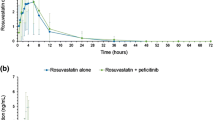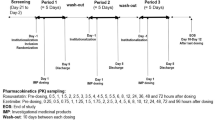Abstract
Objective: Cerivastatin is a novel, synthetic, highly potent 3-hydroxy-3-methylglutaryl coenzyme A (HMG-CoA) reductase inhibitor that effectively reduces serum cholesterol levels at very low doses. It is exclusively cleared from humans via cytochrome P450-mediated biotransformation (demethylation M1; hydro‐xylation M23) and subsequent biliary/renal excretion of the metabolites. The influence of concomitant administration of erythromycin, a potent CYP3A4 inhibitor, on cerivastatin bioavailability and pharmacokinetics was investigated.
Methods: Twelve healthy young male subjects received single oral doses of 300 μg cerivastatin alone or on the 4th day of a 4-day pre- and co-treatment with erythromycin 500 mg t.i.d. in a randomised, non-blind crossover study. Plasma and urine samples were analysed for cerivastatin and its major metabolites by validated specific high-performance liquid chromatography assays.
Results: Cerivastatin was safe and well tolerated. No clinically relevant treatment-emergent changes in laboratory parameters were observed. The pre- and co-treatment with erythromycin 500 mg t.i.d. had a modest influence on cerivastatin clearance, leading to a mean increase in the maximum plasma concentration (Cmax) of 13% and a slightly increased terminal half-life (approximately 10%), resulting in a mean elevation of the area under the curve (AUC) of 21%; time to peak (tmax) remained unchanged. While the mean AUC of the metabolite M1 following the combined dosing was decreased by 60% compared with mono-dosing, the mean AUC of M23 exhibited an increase of approximately 60%. The respective Cmax results paralleled these pronounced effects, whereas the influence on mean terminal half-lives was small (i.e. for M23, an approximate 20% increase) or not observable (i.e. for M1).
Conclusions: Concomitant administration of erythromycin 500 mg t.i.d. affects, to a certain extent, the metabolism of cerivastatin, administered as a single oral dose of 300 μg, resulting in a slightly increased exposure of the parent drug and active metabolites which, however, does not need dose adjustment. In addition, the small increase in cerivastatin half-life does not predict an accumulation beyond steady state. The pharmacokinetic data for the major metabolites suggest that the M1 metabolic pathway is more sensitive to CYP3A4 inhibition than the parallel M23 pathway, supporting recent in vitro findings that further cytochrome P450 isozymes are differently involved in the metabolic pathways of cerivastatin.
Similar content being viewed by others
Author information
Authors and Affiliations
Additional information
Received: 13 August 1997 / Accepted in revised form: 4 October 1997
Rights and permissions
About this article
Cite this article
Mück, W., Ochmann, K., Rohde, G. et al. Influence of erythromycin pre- and co-treatment on single-dose pharmacokinetics of the HMG-CoA reductase inhibitor cerivastatin. E J Clin Pharmacol 53, 469–473 (1998). https://doi.org/10.1007/s002280050408
Issue Date:
DOI: https://doi.org/10.1007/s002280050408




